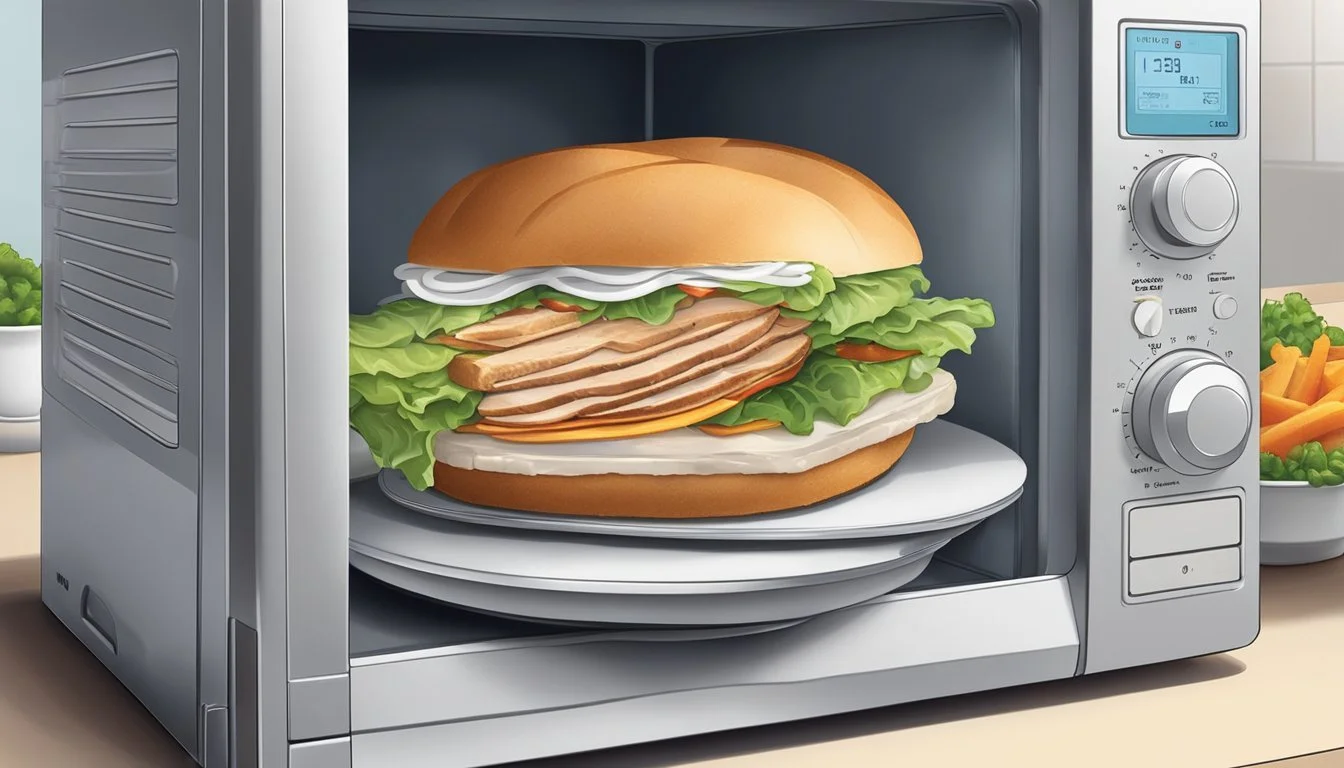Best Way to Reheat a Turkey Sandwich Without Soggy Bread
Expert Tips Revealed
Reheating a turkey (What wine goes well with turkey?) sandwich to preserve the integrity of the bread (What wine goes well with bread?) can be a challenge, yet it is essential for maintaining the sandwich's original taste and texture. When reheated improperly, the bread can become soggy or overly dry, ruining the overall experience. The key is to apply a method that warms the filling effectively while keeping the bread as close to its fresh state as possible.
A popular technique for reheating a turkey sandwich involves the use of an oven or a toaster oven. This method ensures an even distribution of heat and can help retain the bread's crispness. The process requires preheating the oven to a moderate temperature—commonly suggested at around 325°F (163°C)—to avoid toasting the bread too much or drying it out. Wrapping the sandwich in aluminum foil can prevent moisture loss and encourage a gentle reheating process.
The alternative way that offers speed and convenience is using a microwave with a specific lower power setting to gently warm the sandwich components without making the bread rubbery. A short burst in the microwave can bring the turkey filling up to temperature, followed by a quick toast of the bread separately under a broiler or in a toaster to achieve the desired crunch without compromising the bread's quality. Employing a combination of these methods can yield a reheated turkey sandwich that closely resembles its freshly made counterpart.
Understanding the Basics of Reheating
Reheating a turkey sandwich to maintain the perfect texture of bread involves managing moisture, preventing the filling from drying out, and adhering to food safety standards.
The Importance of Moisture Retention
When reheating a turkey sandwich, it's crucial to retain moisture not only in the turkey but also to ensure the bread doesn't become soggy or overly dry. A balance needs to be struck where the heat can warm the inner contents without compromising the bread's quality. Wrapping the sandwich in a pre-moistened paper towel or using a spray bottle to lightly mist the bread can help in maintaining moisture levels.
Preventing Drying Out During Reheating
To prevent the turkey from drying out, one must reheat it carefully. This often involves covering the sandwich, perhaps with a foil or a lid if using an oven or a microwave cover. The method ensures even reheating and helps to lock in moisture. For the turkey, especially, reheating should be done gradually on a lower heat to avoid toughening the protein.
Reheating Times and Temperatures:
Oven: Wrap in foil, reheat at 325°F (165°C) for about 10 minutes.
Microwave: Cover with a damp paper towel, heat on medium power in 30-second intervals.
Food Safety Considerations
Sandwiches (What wine goes well with sandwiches?) with meat such as turkey should always be reheated to an internal temperature of 165°F (74°C) to prevent the risk of foodborne illnesses. One should also ensure that the sandwich hasn't been at room temperature longer than two hours before reheating. Using a food thermometer is the best way to confirm the sandwich has reached the safe temperature throughout.
Preparation of Turkey Sandwich for Reheating
When reheating a turkey sandwich, the goal is to restore the flavors and warmth of the fillings without compromising the texture of the bread. Proper wrapping and storing techniques are vital steps before reheating.
Wrapping Techniques for Retaining Freshness
To keep the turkey sandwich fresh before reheating, one should wrap the sandwich in aluminum foil. This method serves a dual purpose: it retains the sandwich’s moisture and ensures even reheating. One should carefully wrap the sandwich, making sure:
The aluminum foil covers the sandwich completely
Any openings in the foil are sealed to prevent steam from escaping
Storing Leftover Sandwiches
For storing leftover sandwiches, proper containment is essential to maintain quality and prevent contamination. Leftover sandwiches should be placed in a zip-top bag or an airtight container to prevent the entry of air and moisture, which can spoil the turkey and make the bread soggy. The steps are as follows:
Separate the turkey from the bread if possible. This prevents the bread from becoming too moist.
Place the turkey and the bread in individual zip-top bags or wrap them separately in foil.
Store them in the coolest part of the refrigerator to ensure maximum freshness.
By following these preparation steps, the turkey sandwich will be well-preserved for reheating, leading to a more enjoyable meal when it's time to eat.
Reheating Methods Overview
Choosing the right reheating method is essential for preserving the texture and flavors of a turkey sandwich. The following subsections outline the best techniques for reheating using different kitchen appliances.
Oven Reheating Method
To reheat a turkey sandwich in the oven, it is recommended to preheat the oven to 350°F. The sandwich should be placed on a baking sheet and loosely covered with aluminum foil to prevent the bread from drying out. Typically, heating for 10-15 minutes warms the sandwich through. For a crispier crust, the foil can be removed and the sandwich heated for an additional 5 minutes.
Microwave Reheating Method
Using a microwave for reheating sandwiches can lead to a softer texture, particularly if reheated briefly. For a turkey sandwich, one might dampen a paper towel and wrap it around the sandwich to create steam and prevent the bread from becoming too tough. Heating the sandwich for 30-second intervals on medium power checks for desired warmth without compromising texture.
Stovetop Reheating Method
Stovetop reheating can yield a crispy texture for your sandwich bread if done carefully. Heat a skillet or griddle over medium heat and place the sandwich inside. Covering with a lid can trap steam and ensure the fillings warm evenly. Flip the sandwich halfway through the heating process to crisp both sides, maintaining a watchful eye to prevent burning.
Toaster Oven Reheating Method
A toaster oven is a suitable option that combines the benefits of oven and microwave reheating. Preheat the toaster oven to 350°F and place the sandwich inside, either wrapped in foil for moisture retention or unwrapped for a crispier texture. The sandwich should heat for about 10 minutes, and similar to the oven method, the foil can be removed for additional toasting if required.
Adding Supplementary Moisture
When reheating a turkey sandwich, the primary goal is to prevent the bread from drying out while restoring the warmth and juiciness to the turkey. A balanced application of moisture can aid in rejuvenating the turkey without compromising the texture of the bread.
Using Broth or Stock
Heating a turkey sandwich with the addition of broth or stock is a strategy to reintroduce moisture directly to the turkey. One should consider the following steps:
Pour a small amount: Gently drizzle a thin layer of chicken or turkey broth or stock over the turkey slices, being careful not to soak the bread.
Heat cautiously: Warm the sandwich in an oven preheated to a low temperature, ensuring that the bread remains covered while the meat absorbs the moisture.
Applying Butter or Oils
Butter or oils can provide a supplementary moisture layer that enhances both the flavor and texture of the turkey in a sandwich. The approach involves:
Softened butter: Spread a light layer of softened butter over the turkey before reheating. Butter forms a barrier that helps retain internal moisture while adding richness.
Healthy oils option: For a lighter alternative, one can brush olive oil lightly over the turkey. Olive oil offers a subtle flavor while maintaining the desired moisture level.
Serving and Enjoying the Reheated Sandwich
Once a turkey sandwich is reheated properly, it transforms into a delightful meal that rivals its freshly-prepared counterpart. Focusing on proper serving and optimal pairing with sides and condiments can elevate the dining experience.
Accompaniments
Additional Uses for Leftover Turkey
Transforming leftover turkey from a Thanksgiving feast into new and flavorful dishes ensures that none of the holiday bounty goes to waste. Two excellent avenues for culinary creativity with the remaining bird include crafting unique recipes and integrating turkey into hearty soups and stews.
Creative Recipes for Turkey Leftovers
Enchiladas: A festive way to repurpose turkey is by making turkey enchiladas. One takes shredded leftover turkey, wraps it in corn tortillas, covers it with a robust enchilada sauce, and finishes it with a sprinkle of cheese before baking.
Turkey Tetrazzini: This classic dish combines leftover turkey with spaghetti, mushrooms, and a creamy sauce. Topped with breadcrumbs and parmesan cheese, turkey tetrazzini is baked until golden and bubbly, offering a comforting meal.
Making Soups and Stews
Turkey Soup: Utilizing the turkey bones to create a rich stock is the foundation for a nourishing soup. Adding vegetables, barley, or noodles contributes substance, while the leftover turkey meat brings protein.
Turkey Stew: For a heartier option, stew is ideal. The robust flavors of root vegetables and herbs simmered alongside tender chunks of reheated turkey make for a satisfying meal, especially during colder seasons.
Long-Term Storage and Freezing Techniques
Proper long-term storage and freezing techniques ensure that a turkey sandwich maintains its quality over time. These methods focus on preserving the freshness of the turkey pieces and preventing the bread from becoming soggy.
Properly Freezing Sandwiches for Later
When freezing a turkey sandwich, one should wrap individual portions securely to avoid freezer burn and flavor loss. Wrapping should be done as follows:
Cool the roasted turkey completely to room temperature to prevent condensation, as moisture is detrimental to both texture and flavor.
Separate the turkey pieces from the bread to prevent the bread from soaking up any moisture from the turkey.
Wrap the turkey tightly in plastic wrap, followed by aluminum foil or place it inside a freezer-safe bag. Squeeze out excess air before sealing.
Store the bread in a separate airtight bag or container, ensuring it's completely dry to avoid ice crystal formation.
The USDA recommends that for optimal quality, frozen sandwiches should be consumed within 1 to 2 months.
Defrosting and Reheating Frozen Sandwiches
Defrosting and reheating are critical stages in preserving the sandwich's quality. They should be approached as follows:
To defrost, one should transfer the sandwich components from the freezer to the refrigerator and allow them to thaw slowly, ideally overnight. Quick temperature changes can negatively impact texture and taste.
To reheat a frozen sandwich, especially if combined with the bread, one could wrap the sandwich in aluminum foil and heat it in the oven. This process helps retain moisture while warming the sandwich uniformly. For turkey pieces, a temperature of 165°F is considered safe by the USDA.
Reheating a frozen sandwich directly without defrosting is not recommended as it can lead to uneven heating and a substandard final product.
Remember, whether freezing, defrosting, or reheating, maintaining a steady temperature and avoiding direct exposure to air will help keep sandwiches as fresh as possible.




